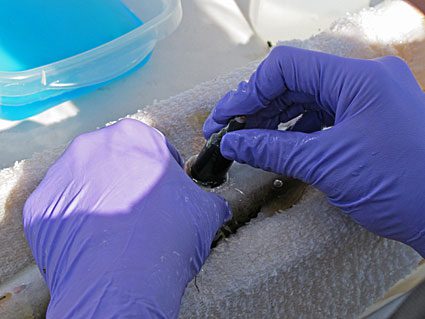Monday October 25, 2010

Surgically implanting acoustic transmitters into fish requires considerable equipment, planning, and preparation. The task is difficult to accomplish in a laboratory environment, and even more complicated in the field. In the outdoor environment, it is just as important to ensure surgical equipment is disinfected and the challenge is to keep everything as sterile as possible. Before surgery a fish is introduced to a bath of anesthesia, where it will lose equilibrium and responsiveness in one or two minutes. Once the fish rolls on to its side, it is removed from the anesthesia, measured, weighed, and placed upside-down in a fish cradle. The cradle helps to maintain the fish in position during surgery and a tube with diluted anesthesia administered through the mouth keeps the fish motionless throughout the procedure. A 3-4 cm incision is made ventral to the mid-line and anterior to the pelvic girdle. The acoustic transmitter is gently inserted into the abdominal cavity and 3 to 4 sutures are used to close the opening. The fish is returned to a freshwater net-pen to recover before release. Given the size of the fish and the importance of a swift procedure, the surgery requires substantial practice, patience and skill.

The fish above is one of many trout (Oncorhynchus mykiss) that are being implanted with acoustic transmitters as part of a research project to evaluate migration characteristics. Research questions include, examining factors that influence anadromous and resident O. mykiss life-history strategies, the response of individuals to environmental factors, and the extent of in-stream movements. The transmitters are HTI Model 795LX tags (Hydroacoustic Technology, Inc., Seattle, WA) that emit an underwater sound (i.e. “ping”) at a frequency of 307 kHz, which can be uniquely identified by an acoustic receiver (i.e. “hydrophone”). Each tag weighs 13 grams in air, and at a ping rate of 10 seconds pulse repetition interval (PRI) the average 795LX tag lasts 300 days. The tag “life” can be extended by increasing the PRI or decreasing the pulse width. In order to provide a unique signal for each tag, HTI programs the tags with slightly different pulse periods, an approach that differs from techniques used by other acoustic telemetry companies.
![]()
The movements of tagged fish are monitored with both mobile and fixed acoustic receivers. At fixed locations, solar powered monitoring stations record fish movement 24 hours/day, year round. A Model 295G data logger, above water, is attached by long cables to a hydrophone, strategically placed underwater, which detects and amplifies the signal. Fish movements are also evaluated intermittently using mobile tracking, in which a hydrophone is mounted to a raft as shown in the photo above. Depending on the relevant research questions, mobile tracking can provide an efficient way to increase coverage of a large study area by locating the fish even when they are out of range of the fixed stations – kind of like an at-home follow up visit.
Check the Field Notes page for a description of our solar powered tracking station in an upcoming post.
Photo source: FISHBIO
